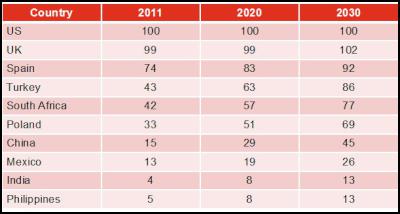Shrinking emerging market wage gap will re-shape businesses
Shrinking emerging market wage gap will re-shape global businesses
The wage gap between advanced economies and emerging economies, such as China, India and the Philippines will shrink significantly by 2030 according to new analysis published today by PwC (see table below).
India and the Philippines remain at the lower end of wage projection in relative terms, but average wages in India could more than quadruple over the period in real dollar terms and more than triple in the Philippines. Real wages in the UK and US are projected to rise by only around a third over the same period, remaining at similar levels to each other.
More striking is how substantially the wage gap could close by 2030. India’s current average monthly wage is around 25 times smaller than that of the UK. By 2030, it’s likely it be only 7.5 times smaller. Average wages in US are currently 7.5 times greater than in Mexico, but the gap could close to a factor of less than 4 times by 2030. Over the same time period, the average monthly Chinese wage could rise to around half that of Spain.
John Hawksworth, chief economist at PwC, said:
“While any such projections are subject to significant uncertainties, the direction of change is clear. The large wage advantages enjoyed today by many emerging economies will shrink as their productivity levels catch up with those in advanced economies and their real exchange rates rise as a consequence.
“Places like Turkey, Poland, China and Mexico will therefore become more valuable as consumer markets, while low cost production could shift to other locations such as the Philippines. India could also gain from this shift, but only if it improves its infrastructure and female education levels and cuts red tape.”
Projected average monthly wage levels relative to
US index = 100

Click for big version.
Source: PwC projections based on ILO data for 2011; real wages index relative in each year to US = 100
These trends have a number of potential implications for business strategy as:
1. Companies re-shore their manufacturing or service operations, as some US companies have already started to do, or else move them to cheaper locations.
2. As current large cost advantages decline, companies move to locations that are initially more expensive but closer to home, gaining more control over supply chains to respond to customers’ changing needs.
3. Middle income economies Turkey, Poland and China begin offshoring to relatively cheaper economies like Vietnam, India and the Philippines.
4. Current ‘Western’ offshorers (to India
and China, for instance) reorient their operations to sell
their goods and services to increasingly affluent local
populations.
Michael Rendell, PwC partner and Global
Human Resource Services leader, said:
"Change is continuous and there will be even more movement in the coming years. Companies planning for this today will find themselves with significant advantages, particularly in terms of people costs. It's inevitable that the manufacturing and services industries in countries will transform as the cost base evolves, and also that there will be winners and losers. Governments, regulators and business communities need to be ready for that shift."
Notes to editors:
1. The PwC
analysis is based on estimates of relative average monthly
wage levels from the International Labour Organisation
(ILO), projected forward to 2030 using results from PwC’s
latest ‘World in 2050’ report, which is available from
http://www.pwc.com/en_GX/gx/world-2050/the-brics-and-beyond-prospects-challenges-and-opportunities.jhtml
.
2. The real wage projections are in dollar terms and
so allow both for domestic real wage growth driven by
projected labour productivity trends and estimated future
real exchange rate movements. Further methodological details
are included in the accompanying slide pack, which also
includes projections based on US Bureau of Labour Statistics
hourly manufacturing wage data for a smaller set of emerging
market countries. The ILO data relate to estimated average
monthly wages across the economy as a whole, not just
manufacturing. It should be borne in mind that there are
significant difficulties in getting fully comparable wage
level data across economies, so these estimates are subject
to significant margins of error.
About PwC
PwC helps organisations and individuals create the value they’re looking for. We’re a network of firms in 158 countries with more than 180,000 people who are committed to delivering quality in assurance, tax and advisory services. Tell us what matters to you and find out more by visiting us at www.pwc.com.
PwC refers to the PwC network and/or one or more of its member firms, each of which is a separate legal entity. Please see www.pwc.com/structure for further details.
2013 PricewaterhouseCoopers. All rights reserved.
PwC_Global_wage_projections_to_2030_September_2013.pdf
ENDS


 Financial Markets Authority: FMA Seeks Clarity From High Court On Use Of Eligible Investor Certificates In Wholesale Investment Sector
Financial Markets Authority: FMA Seeks Clarity From High Court On Use Of Eligible Investor Certificates In Wholesale Investment Sector Scion: Scion’s Novel Internship Model Connects Talent With Industry
Scion: Scion’s Novel Internship Model Connects Talent With Industry Financial Markets Authority: Westpac Admits To Misleading Representations That Resulted In $6.35m In Overcharges
Financial Markets Authority: Westpac Admits To Misleading Representations That Resulted In $6.35m In Overcharges Bill Bennett: Download Weekly - Review Of 2024
Bill Bennett: Download Weekly - Review Of 2024 Bill Bennett: One NZ scores worldwide first as Starlink direct-to-mobile launches
Bill Bennett: One NZ scores worldwide first as Starlink direct-to-mobile launches Hugh Grant: How To Reduce Network Bottlenecks
Hugh Grant: How To Reduce Network Bottlenecks



